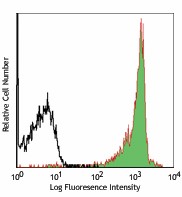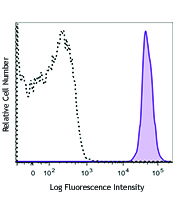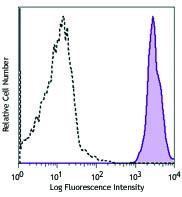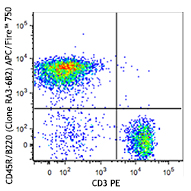- Clone
- 30-H12 (See other available formats)
- Regulatory Status
- RUO
- Other Names
- Thy-1.2
- Isotype
- Rat IgG2b, κ
- Ave. Rating
- Submit a Review
- Product Citations
- publications

-

C57BL/6 mouse thymocytes stained with 30-H12 Alexa Fluor® 700
| Cat # | Size | Price | Quantity Check Availability | Save | ||
|---|---|---|---|---|---|---|
| 105319 | 25 µg | £70 | ||||
| 105320 | 100 µg | £157 | ||||
CD90.2 is a 25-35 kD immunoglobulin superfamily member also known as Thy1.2. It is expressed on hematopoietic stem cells and neurons, all thymocytes, and peripheral T cells in Thy1.2 bearing mouse strains (Balb/c, CBA/J, C3H/He, C57BL/-, DBA, NZB/-). CD90.2 is a glycosylphosphatidylinositol (GPI)-anchored membrane glycoprotein involved in signal transduction. CD90.2 is involved in costimulation of lymphocyte proliferation and induction of hematopoietic stem cells differentiation. CD90.2 has been shown to interact with CD45. The 30-H12 antibody has been reported to induce Ca2+ flux in thymocytes and, in combination with antibody against the CD3/TCR complex, promote thymocyte apoptosis and inhibit CD3-mediated proliferative responses of mature T lymphocytes.
Product DetailsProduct Details
- Reactivity
- Mouse
- Antibody Type
- Monoclonal
- Host Species
- Rat
- Immunogen
- Mouse thymus or spleen
- Formulation
- Phosphate-buffered solution, pH 7.2, containing 0.09% sodium azide.
- Preparation
- The antibody was purified by affinity chromatography and conjugated with Alexa Fluor® 700 under optimal conditions.
- Concentration
- 0.5 mg/ml
- Storage & Handling
- The antibody solution should be stored undiluted between 2°C and 8°C, and protected from prolonged exposure to light. Do not freeze.
- Application
-
FC - Quality tested
- Recommended Usage
-
Each lot of this antibody is quality control tested by immunofluorescent staining with flow cytometric analysis. The suggested use of this reagent is ≤ 0.25 µg per 106 cells in 100 µl volume. It is highly recommended that the reagent be titrated for optimal performance for each application.
* Alexa Fluor® 700 has a maximum emission of 719 nm when it is excited at 633nm / 635nm. Prior to using Alexa Fluor® 700 conjugate for flow cytometric analysis, please verify your flow cytometer's capability of exciting and detecting the fluorochrome.
Alexa Fluor® and Pacific Blue™ are trademarks of Life Technologies Corporation.
View full statement regarding label licenses - Excitation Laser
-
Red Laser (633 nm)
- Application Notes
-
Additional reported applications (for the relevant formats) include: in vivo and in vitro depletion1,2,7, costimulation of CD3/TCR-mediated signal transduction3,4, and immunohistochemical staining5 of acetone-fixed frozen sections. The 30-H12 antibody does not react with Thy-1.1 alloantigen of the AKR/J and PL strains. To reduce non-specific binding to cells bearing Fc-receptors, pre-incubation of cells with anti-mouse CD16/CD32, clone 93 (Cat. No. 101301 & 101302) is recommended prior to immunofluorescent staining. The Ultra-LEAF™ purified antibody (Endotoxin <0.01 EU/µg, Azide-Free, 0.2 µm filtered) is recommended for functional assays (Cat. Nos. 105351 & 105352).
-
Application References
(PubMed link indicates BioLegend citation) -
- Hathcock KS. 1991. Current Protocols in Immunology. 3.4.1. (Deplete)
- Seaman WE. 1983. J. Immunol. 130:1713. (Deplete)
- Nakashima I, et al. 1991. J. Immunol. 147:1153. (Costim)
- Nakashima I, et al. 1993. J. Immunol. 151:3511. (Costim)
- Ledbetter JA, et al. 1980. J. Exp. Med. 152:280. (IHC)
- Hardy B, et al. 2005. Int. Immunol. 17:615.
- Drobyski W, et al. 1996. Blood 87:5355. (Deplete)
- Dyer KD, et al. 2007. J. Immunol. 179:1693. (FC) PubMed
- Sungur CM, et al. 2013. PNAS. 110:7401. PubMed
- Product Citations
- RRID
-
AB_493724 (BioLegend Cat. No. 105319)
AB_493725 (BioLegend Cat. No. 105320)
Antigen Details
- Structure
- Ig superfamily, 25-35 kD
- Distribution
-
Hematopoietic stem cells and neurons, all thymocytes, peripheral T cells of the Thy-1.2 bearing mice
- Function
- Lymphocyte costimulation, proliferation and differentiation of hematopoietic stem cells
- Ligand/Receptor
- CD45
- Cell Type
- Hematopoietic stem and progenitors, Neurons, T cells, Thymocytes
- Biology Area
- Immunology
- Molecular Family
- CD Molecules
- Antigen References
-
1. Barclay A, et al. 1997. The Leukocyte Antigen FactsBook Academic Press.
2. Craig W, et al. 1993. J. Exp. Med. 177:1331.
3. Reif AE and Schlesinger M. 1989. Cell Surface Antigen Thy-1.
4. Mayani H, et al. 1994. Blood 83:2410. - Gene ID
- 21838 View all products for this Gene ID
- UniProt
- View information about CD90.2 on UniProt.org
Related Pages & Pathways
Pages
Customers Also Purchased
Compare Data Across All Formats
This data display is provided for general comparisons between formats.
Your actual data may vary due to variations in samples, target cells, instruments and their settings, staining conditions, and other factors.
If you need assistance with selecting the best format contact our expert technical support team.
 Login / Register
Login / Register 

















Follow Us